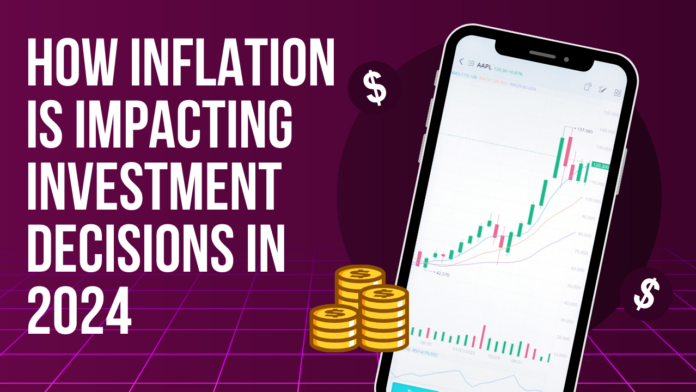Introduction to Inflation and its Causes
Inflation is a term that has been on everyone’s lips lately. It’s more than just economic jargon; it directly impacts our wallets and investment choices. As we navigate through 2024, understanding inflation’s causes and effects becomes crucial for anyone looking to secure their financial future.
What fuels inflation? Factors like rising demand, supply chain disruptions, and changes in monetary policy can all contribute to the increasing cost of living. With prices climbing, investors must adapt quickly. How do you protect your savings against inflation while still growing your wealth?
This blog will explore how inflation influences investment decisions today and what strategies you can employ to thrive in this challenging environment. Whether you’re an experienced investor or just starting out, it’s essential to stay informed about the best ways to invest during these times of uncertainty. Let’s dive into the current state of inflation and uncover smart investing opportunities tailored for 2024!
The Current State of Inflation in 2024
The year 2024 has ushered in a complex landscape of inflationary pressures. Rates have hovered around levels not seen in decades, prompting widespread concern among economists and investors alike.
Supply chain disruptions continue to plague industries globally, contributing to rising prices on everyday goods. Energy costs remain volatile as geopolitical tensions affect oil markets, fueling further inflationary trends.
Consumer behavior is shifting as households grapple with the impact of higher living costs. Many are adjusting budgets and reconsidering major purchases, which adds another layer of uncertainty for businesses.
Central banks face tough choices regarding interest rates. While some advocate for aggressive hikes to rein in inflation, others caution against stifling economic growth too quickly.
In this environment, understanding how inflation influences various sectors becomes crucial for strategic investment decisions moving forward.
Effects of Inflation on Investment Decisions
Inflation plays a pivotal role in shaping investment choices. As prices rise, the purchasing power of money diminishes. This reality compels investors to reassess their portfolios.
Stocks may seem riskier during these times as companies might struggle with increased costs. Investors often wonder if the stock market can truly protect against inflation. Historical data suggests mixed results, leading many to seek alternative strategies.
Real assets like real estate and commodities gain attention as potential hedges against inflation. Gold frequently emerges as a favored option due to its historical status as a safe haven.
Bonds also come under scrutiny. Fixed annuities may not provide adequate protection unless they have inflation-adjusted features. Meanwhile, Treasury Inflation-Protected Securities (TIPS) offer some relief by adjusting principal based on rising prices.
Investors must remain vigilant and proactive in navigating this challenging environment where traditional strategies could falter amid rising costs.
Strategies for Investing During High Inflation
When inflation spikes, traditional investment strategies may falter. Adapting is crucial.
Consider incorporating assets that historically perform well during inflationary periods. Real estate stands out; it often appreciates and can generate rental income.
Another option includes Treasury Inflation-Protected Securities (TIPS). These bonds adjust with inflation, providing a safeguard for your capital.
Gold and other precious metals also serve as reliable hedges against rising prices. Their intrinsic value tends to rise when currency loses purchasing power.
Diversifying your portfolio across sectors like commodities or infrastructure can further protect against volatility. These investments might not only withstand inflation but could thrive in an economic landscape marked by price increases.
Exploring dividend-paying stocks may provide ongoing cash flow while potentially appreciating over time—a dual benefit during high-inflation episodes.
Alternative Investment Options During Times of Inflation
During times of inflation, traditional investments may not always provide the necessary protection. This is where alternative options come into play.
Real estate often shines as a strong contender. Property values and rental income typically rise with inflation, making it a tangible asset that can protect your wealth.
Cryptocurrencies have emerged as another option. While volatile, they are increasingly viewed as digital gold, potentially offering hedging benefits against fiat currency devaluation.
Commodities like oil and agricultural products also attract attention during inflating conditions. Their inherent value often increases when prices soar across the economy.
Collectibles such as art or vintage cars can serve as unique investments too. These assets may appreciate over time and aren’t directly tied to market fluctuations in the same way stocks are.
Exploring these alternatives could diversify your portfolio while aiming to mitigate risks associated with rising inflation rates.
Preparing for Future Inflation: Tips and Advice
Staying ahead of inflation requires proactive planning. Begin by reviewing your investment portfolio regularly. Diversification is key; consider spreading assets across different sectors and geographies.
Next, keep an eye on monetary policy trends. Central banks often adjust interest rates in response to inflation shifts. Understanding these patterns can help you make informed decisions about when to buy or sell assets.
Consider incorporating inflation-protected securities into your investments. Options like Treasury Inflation-Protected Securities (TIPS) can provide a safety net against rising prices.
Don’t overlook the value of real assets, such as real estate or commodities like gold. These tend to hold their value better during periods of high inflation.
Maintain an emergency fund with cash reserves that allow for flexibility without sacrificing potential gains from long-term investments. This balance will enable you to navigate uncertainties more effectively.
Conclusion: Making Informed Investment Decisions Despite Inflation
Navigating the investment landscape in 2024 requires a keen understanding of inflation and its implications. As inflation rates fluctuate, they influence various asset classes, prompting investors to rethink their strategies.
It’s crucial to stay informed about the current state of inflation and its drivers. By recognizing how it impacts purchasing power and market dynamics, you can make more educated decisions regarding your investments.
Consider diversifying your portfolio with assets that tend to hold value during inflationary periods. This could include real estate, commodities like gold as a hedge against inflation, or bonds designed specifically for protection against rising prices. Evaluating alternative investment options is essential in this climate.
Adopting proactive strategies can further bolster your financial standing. Keeping an eye on interest rates and adjusting accordingly will help protect savings against inflation while seeking opportunities that offer growth potential without excessive risk.
Staying ahead means being adaptable and responsive to changes in economic conditions. By developing a robust investment strategy tailored for high inflation environments, you’ll be better equipped to navigate uncertainties while maximizing returns amidst rising costs. Remember that making informed choices today lays the groundwork for future financial stability.


